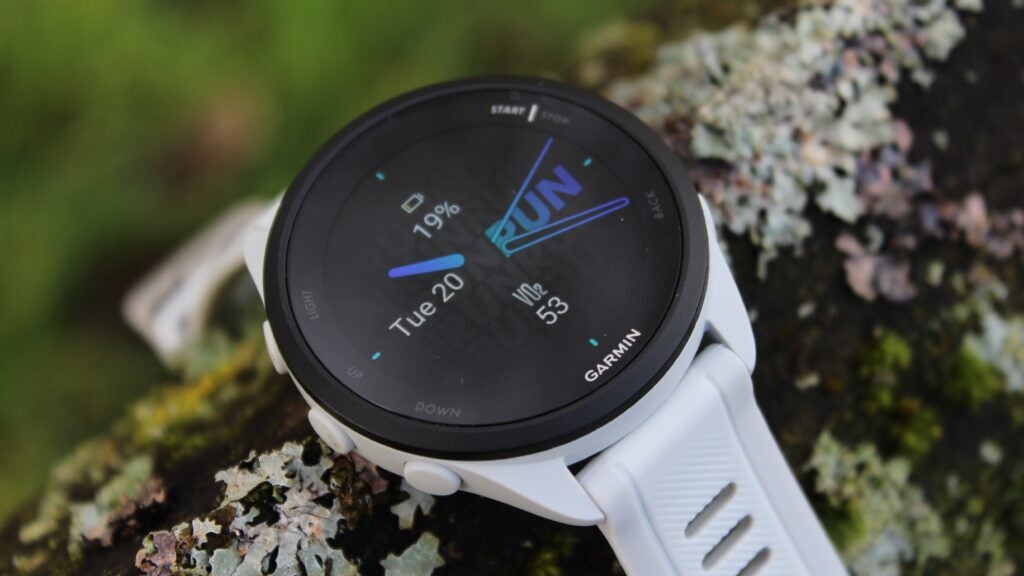Verdict
The Garmin Forerunner 165 delivers some excellent features for runners in a package that’s easy to wear and long-lasting. With accurate heart rate monitoring and GPS in tow, too, it becomes a superb option for beginners and intermediates – even if adding music support ensures some of that value is lost.
Pros
- Superb AMOLED display and UI
- Reliable GPS and HR tracking
- Battery life is excellent
Cons
- Separate edition for music support
- GPS lock-on is slow
- Rival watches are cheaper
-
AMOLED displayThe Forerunner 165 becomes the cheapest Garmin running watch to feature the bright and detailed screen type -
Two editionsGarmin offers a standard version and a more expensive Forerunner 165 Music for those who want support for Spotify etc -
Efficient batteryGarmin promises 11 days of battery life in ‘smartwatch mode’ – or 19 hours when tracking with GPS
Introduction
Garmin continues to provide a shot of colour to its running watches, this time plugging a much-needed gap in its collection with the Forerunner 165.
An entirely new line for the company (there was no Forerunner 155), the Forerunner 165 provides those desperate for an AMOLED-packing Garmin watch under £250/$250 with a compelling option to consider. And with rivals Coros and Polar releasing watches around this mark over the last year, Garmin is finally catching up.
It’s not yet clear whether this represents the new point of entry for Garmin’s running watches, but the feature set on offer here is undoubtedly similar to its current cheapest, the Forerunner 55. Those just getting into running – or intermediates who don’t want to shell out for the loftier Forerunner 265s – are well-catered for.
Design and Display
- The AMOLED screen is an excellent addition
- Light design isn’t the most attractive
- Only one case size
Putting on the Forerunner 165 is reassuring and familiar. It’s also immediately evident through the lightweight polymer case why it’s much more affordable than the likes of the FR265 and FR965. For workouts, it’s the ideal design – though I am sure many will also replace it outside of runs for something a little more durable or attractive.
While the offer of only a single case size here might feel like a missed opportunity, I was pleasantly surprised about how well the Forerunner 165 looked on both small and large wrists. That unisex appeal is also present across the four colour options – white/grey, black/black, aqua/grey, and pink/navy.
It’s functional and reminiscent of older Forerunner models, such as the Forerunner 235 or Forerunner 945. However, the real star of the show is the display.
As mentioned up top, Garmin’s memory-in-pixel (MIP) screens of the past are rapidly being replaced by vibrant AMOLED panels.
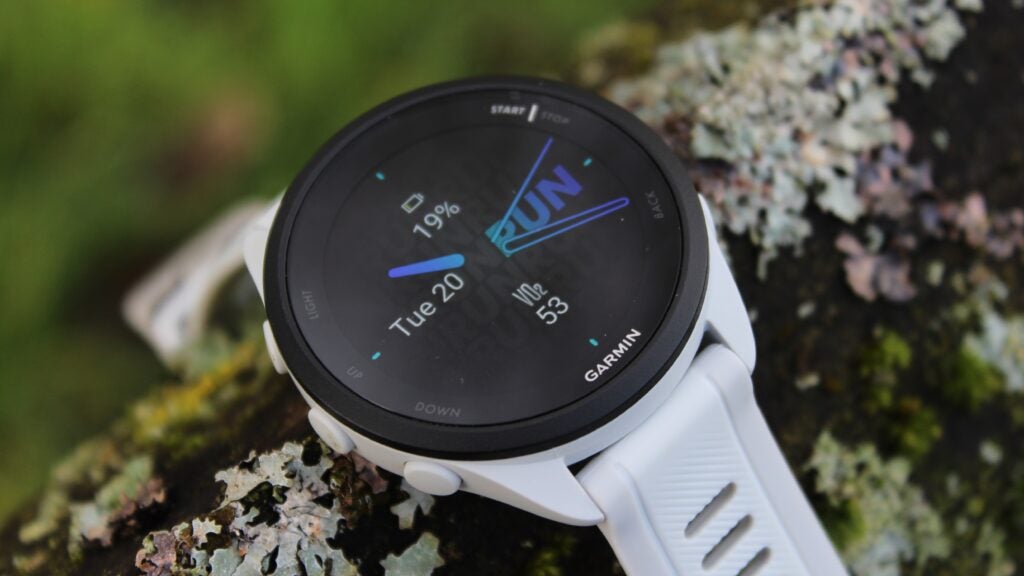

While not everyone will love the brightness, I think the newer display tech is unquestionably a huge upgrade. It delivers superior detail and clarity – even in direct sunlight – and does so without becoming a burden on battery life.
The upgrade isn’t just about poppy new colours, either. The UI used on these latest Forerunner models is really friendly; punchier than older versions and more readable than even the flagship Epix Pro (Gen 2).
It’s not perfectly tailored to the 1.2-inch screen, with the odd watch face looking out of place, but it remains super responsive whether you navigate with touch or the classic five-button array.
The one caveat? Durability. The plastic case is more susceptible to scratches and nicks than what you’ll find with the very best Garmin watch, and it’s something to keep in mind if your adventures extend beyond running.
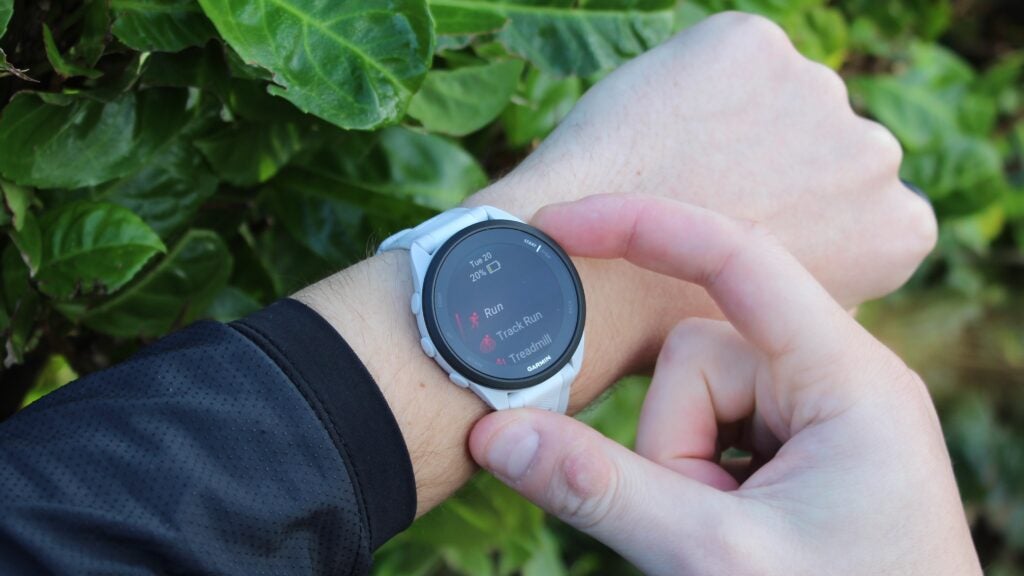

Overall, though, the FR165 offers a familiar fit with a fresh, colourful upgrade. Purely from a design perspective, it’s a solid choice for budget-conscious runners.
Fitness Tracking
- A good range of features for the price
- Wrist-based Run Dynamics
- Mostly accurate data
The 165 packs a solid punch when it comes to running features, aiming to please both value-seekers and avid runners.
For the most part, it follows Garmin’s typical form when walking this tightrope; the features that are present are very good, but the asking price is just a tad lofty for the number of them on offer.
So, while you get key metrics like VO2 Max, race planning tools, and daily workout suggestions, some run-focused metrics are also missing.
I can forgive something like Training Status being omitted, as this is a pretty deep analysis of your overall training load from every activity (not just running), but it’s semi-disappointing to see Training Readiness stripped back to only include recovery hours.
Then there are the latest insights – Endurance Score and Hill Score – which I wouldn’t expect to trickle down to this price point for another generation or two.
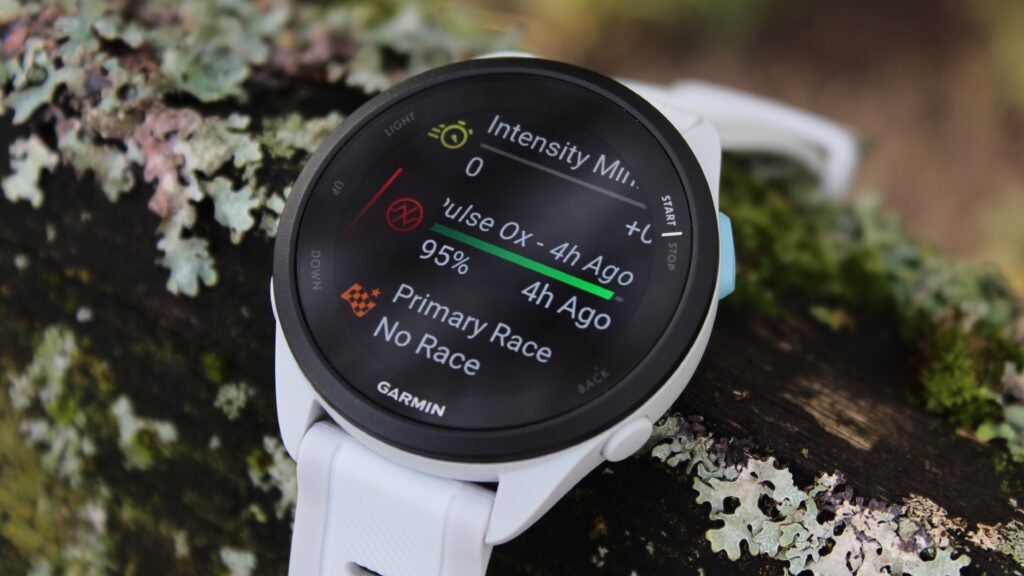

Surprisingly, the Forerunner 165 offers wrist-based Run Dynamics, typically reserved for top-tier Garmins. This granular look into things like ground contact time and vertical oscillation might confuse beginners, so the placement here is odd, but the accuracy does at least stack up very well to a Garmin chest strap.
The ideal user here is the runner who wants core insights and guidance, but anybody looking for advanced load analysis or recovery recommendations will be found wanting more.
As you would expect at this price point, Garmin hasn’t included support for its Multi-Band/dual-frequency GPS tracking. You’ll have to upgrade to at least the 265 for the more advanced and accurate location tracking, but, as I found during my testing, the standard version of Garmin’s GPS still holds its own – particularly when avoiding built-up areas like cities or forests.
Over a couple of weeks of testing, I did find that the watch has a slight tendency to overreport distance when compared to a Multi-Band tracker like the Epix Pro (Gen 2). However, it’s certainly not enough to get worked up about. One 16-mile run only saw it register a 500m difference, while it logged 200m more than the Epix Pro over a couple of shorter runs.
While everyone wants perfect GPS, this is about as good as it gets at this price – and something I would have been pretty pleased with as a beginner runner.
The bigger issue – and one I haven’t really encountered in a full-blooded running watch in a while – was a slow GPS lock-on. On almost every occasion, the Forerunner 165 struggled to gain a connection (in a very residential area) for 4-5 minutes.
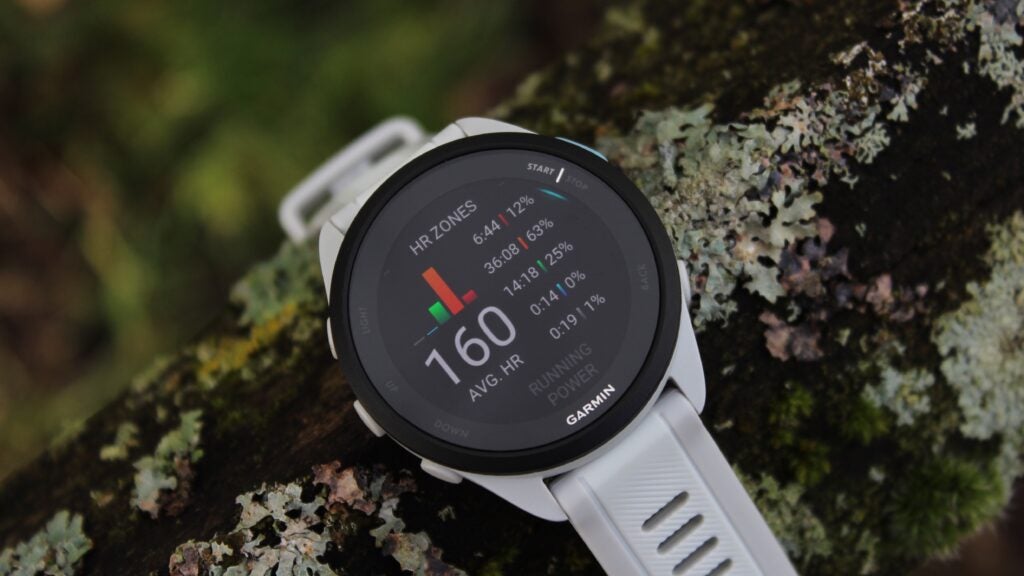

Heart rate monitoring follows a similar theme to GPS tracking, with the Forerunner 165 featuring the Elevate V4 optical heart rate sensor and not Garmin’s all-new V5 sensor.
Again, like with Multi-Band, it’s not unexpected or unjustified – and the results again show this older tech holding its own.
I tested against the Garmin HRM-Pro Plus chest strap in all runs – one of the gold-standard devices when it comes to consumer-grade accuracy. Often I see watches struggle to match up to the chest strap’s max HR reading but stay relatively close to the average HR figure, but the 165 fared well in both respects in almost every run.
It only had one mild slip-up, in which the max HR reading was 10bpm higher than the HRM-Pro Plus and had a skewed average HR number, as a result. The rest of my runs saw it underreport (both average HR and max HR) by a couple of beats, which, for a device at this price, is pretty good going.
I was particularly encouraged by how it fared on different types of runs. Optical HR sensors will always lag behind chest straps when it comes to latency, but the Forerunner 165 managed to perform comparably with the HRM-Pro Plus over a workout that included nine intervals just as well as a steady long run.
Features
- No game-changing sleep or health features
- Music skills limited to specific models
With higher-end Forerunners lacking game-changing health, sleep, and smart features, I certainly wasn’t expecting this cheaper model to break new ground in these areas. It doesn’t, and, for something designed to be a pure running watch, that’s perfectly acceptable.
However, music support is a bit of a sore spot. It’s one of the few smart features offered alongside basic notifications and Garmin Pay (whose limitations persist outside the US) – and Garmin is asking those who want it to pay a premium by picking up the Music edition
It’s a hike that takes the price from $249.99/£249.99 (already higher than rival offerings) to £289.99/$299.99. It’s nothing new – Garmin has walled off music support before – but it just feels a little needless in this instance.
Beyond the music issues, there’s a decent array of other features. HRV Status accurately aids recovery and is still something I prefer the presentation of to Oura and Whoop, while Body Battery returns with improvements.
Pulse Ox monitors SpO2, but that’s the extent of advanced health tools. Again, perfectly acceptable for a budget running watch.
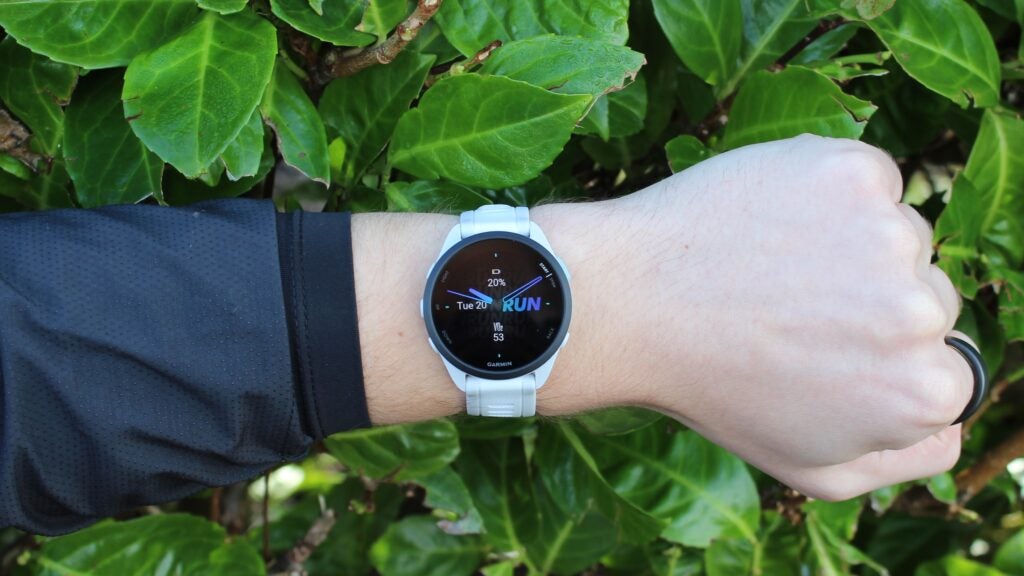

Sleep tracking remains hit-and-miss compared to the rest of the industry, however, even with the long-awaited addition of nap tracking making an appearance here. Sleep Scores are the best example of this mixed showing. Some scores are nearly identical to the Epix Pro on our opposite wrist, while others are 10 points (or more) out.
Features like sleep scores or sleep stage analysis are notoriously inaccurate across wearables, with sleep labs offering the only reliable insights, so I don’t penalize the Forerunner 165 too harshly here.
It excels at tracking the basics, after all: time asleep/wake-up times, even accounting for our typical alarm snoozes.
Battery Life
- Excellent endurance
- Around 7 days of juice with everything turned on
Remember the old concerns everyone used to have about AMOLED displays draining battery life? Garmin has silenced those doubts over the last 12-18 months with its watches, and the Forerunner 165 continues that trend.
While MIP screens might be more efficient, their visual limitations are really clear when compared to AMOLED’s vibrant clarity, with the kicker remaining that Garmin’s display tech still results in around three-quarters of the same battery life as these MIP siblings.
Naturally, battery life always depends on usage, but I put the 165 through our usual test for running watches: max brightness, on-demand Pulse Ox, and always-on display.
Garmin suggests users can get up to 11 days in smartwatch mode, and, while I didn’t test that specifically, my settings saw it last around 7 days, suggesting it easily reaches the company’s claims. Performance during GPS tracking is equally impressive. Two-hour runs saw only 10-12% battery drain, while shorter outings dropped just 5% per hour.
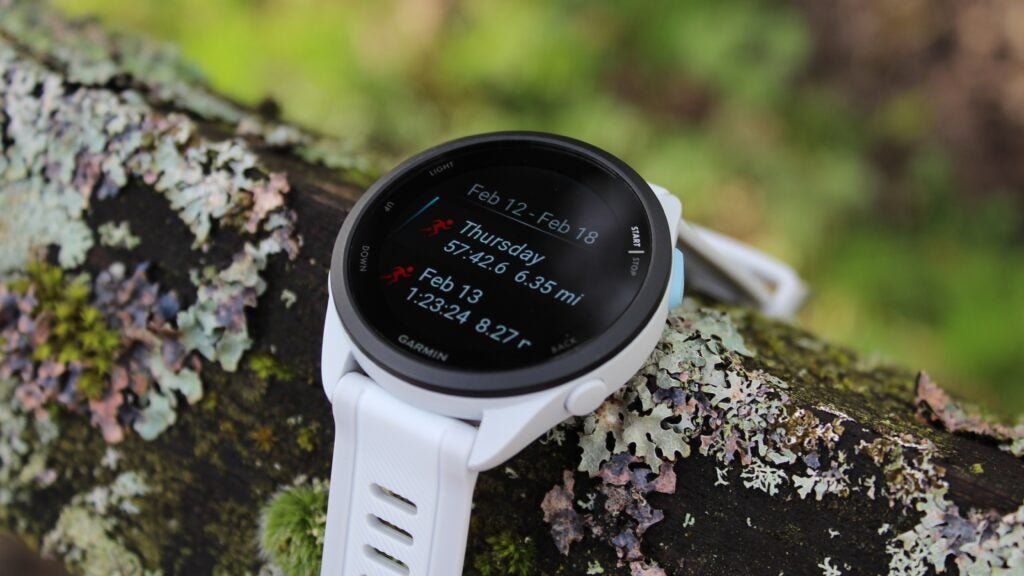

I did test the non-music version, however. With offline Spotify playing via Bluetooth headphones and a chest strap connected, I would expect that battery drain to roughly double. And the music edition doesn’t have any extra battery capacity – it’s the same watch as the standard model except for that one feature.
Overall, though, the Forerunner 165 is another stellar display of Garmin’s AMOLED efficiency. While heavy users pushing the limits might need more, multi-day battery life is guaranteed here.
Should you buy it?
You should buy if you want a great value running watch
For the price, it has lots of great run-focused features and very accurate core tracking.
You shouldn’t buy if you want durability or huge feature lists
Seasoned runners may enjoy more insights and a more enduring design.
Final Thoughts
The Forerunner 165 fills a big gap in Garmin’s running watch collection, giving users at the budget end of the spectrum a good-looking, reliable, and relatively feature-packed option.
Adding music support means it can get pricey, but it’s still an excellent watch for most beginner and intermediate runners to consider. If you’re after something with a few more features, see our ranking of the best Garmin watches.
FAQs
There is a specific Music version that costs a bit more and has music playback features. Sadly the base model lacks this.

